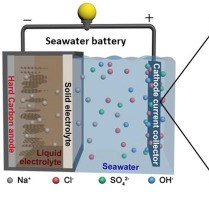Hybridization of cathode electrochemistry in a rechargeable seawater battery: Toward performance enhancement
- Journal
- Journal of Power Sources
- Vol
- 450
- Page
- 227600
- Year
- 2020
Seawater batteries (SWBs) are promising energy storage systems for the future because of their eco-friendly utilization of abundant seawater as low-cost sources of Na ion active cathode materials. However, the overall efficiency (i.e. voltage and/or energy efficiency) and power performance of SWBs are limited by the sluggish kinetics of the oxygen evolution reaction (OER) and oxygen reduction reaction (ORR) on the current collector of the SWB cathode. Generally, the charge storage and delivery process through the electric double layer (EDL) are much faster compared to OER/ORR and other Faradic reactions. To improve the performance of SWBs, we utilized the benefit of EDL formation along with OER/ORR activities using commercial high surface area (~2038 m2 g1) and hydrophilic activated carbon cloth (ACC) as a current collector at the cathode. As anticipated, the SWB with ACC showed a reduced voltage gap (0.49 V), high energy efficiency (86%), improved rate capability, and improved power performance (16.2 mW cm2) compared to those of the SWB operated with lower surface area carbon felt (2.2 m2 g1, 1.24 V, 71%, and 5.5 mW cm2, respectively). These findings suggest that hy-bridization of the EDL and OER/ORR processes on the cathode side of SWB can improve overall performance.

